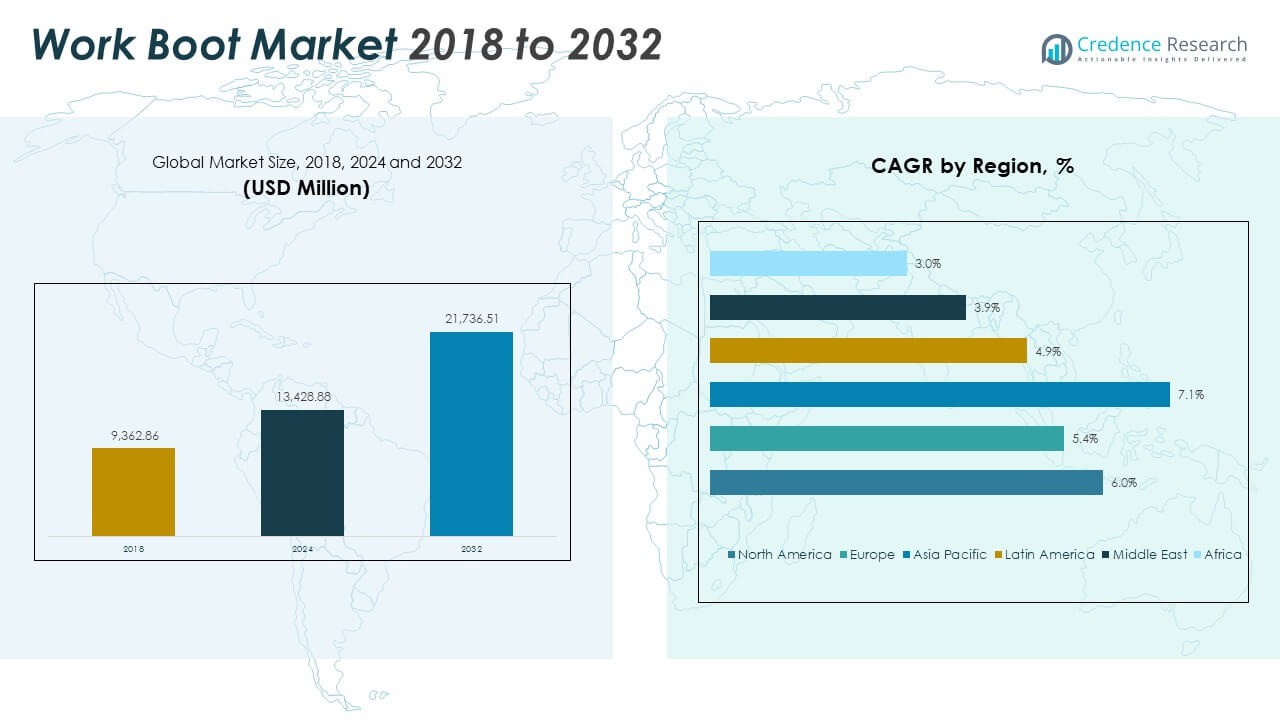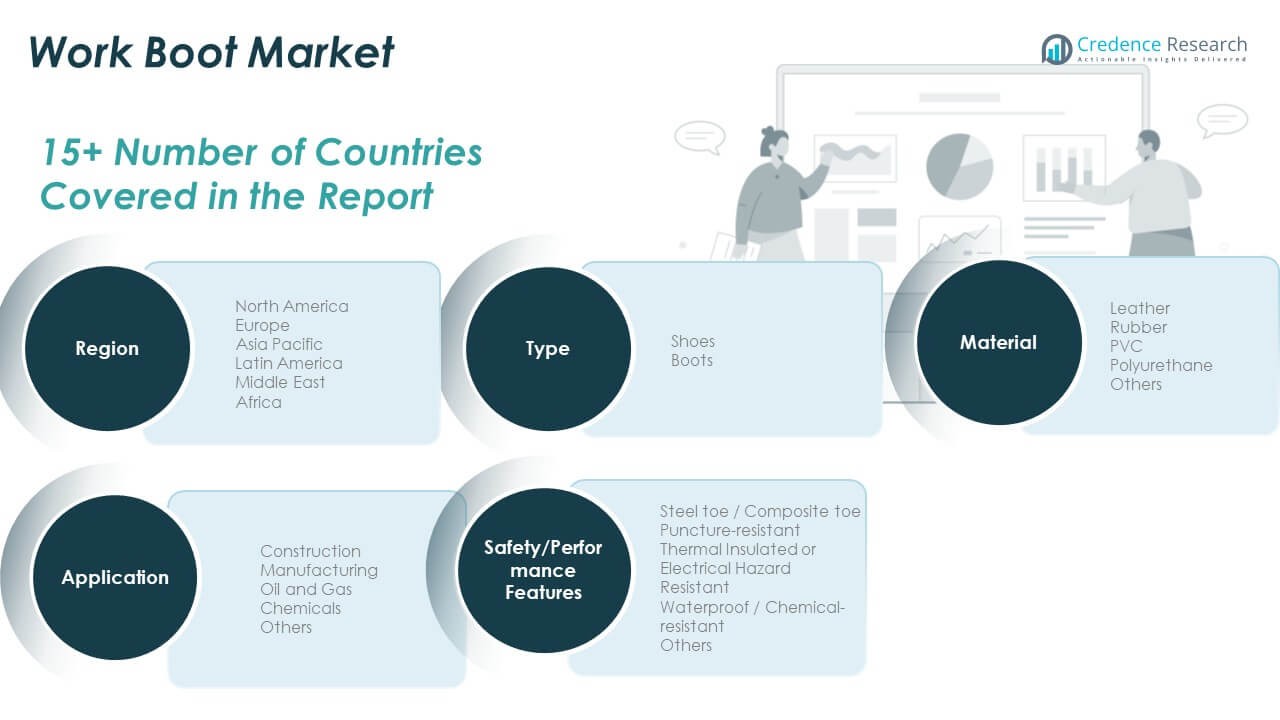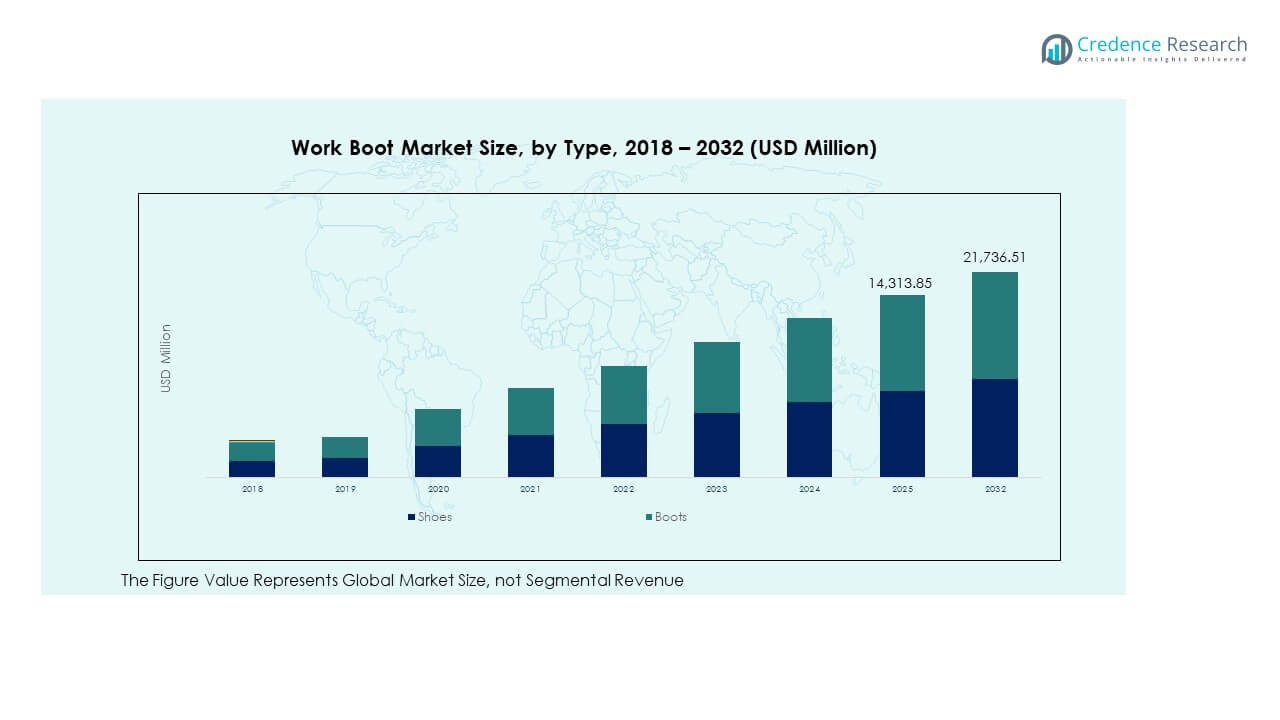Market Overview:
The Global Work Boot Market size was valued at USD 92,783.65 million in 2018, increased to USD 122,076.84 million in 2024, and is anticipated to reach USD 183,517.35 million by 2032, growing at a CAGR of 5.22% during the forecast period.
| REPORT ATTRIBUTE |
DETAILS |
| Historical Period |
2020-2023 |
| Base Year |
2024 |
| Forecast Period |
2025-2032 |
| Work Boot Market Size 2024 |
USD 122,076.84 Million |
| Work Boot Market, CAGR |
5.22% |
| Work Boot Market Size 2032 |
USD 183,517.35 Million |
Growing workplace safety regulations and rising industrialization across developing economies drive the Global Work Boot Market. Demand from construction, mining, oil & gas, and manufacturing sectors continues to rise due to strict safety compliance requirements. Advancements in lightweight, durable, and ergonomic boot designs also attract users seeking comfort and protection. The growing awareness of occupational safety and increasing investment in worker welfare programs further strengthen market expansion.
North America dominates the market due to strong workplace safety laws and widespread use of protective footwear. Europe follows, supported by stringent labor regulations and advanced product innovation. The Asia-Pacific region is emerging as the fastest-growing market, driven by rapid industrial expansion in China, India, and Southeast Asia. Growing infrastructure development, construction activities, and labor-intensive manufacturing are boosting adoption in these emerging economies.
Access crucial information at unmatched prices!
Request your sample report today & start making informed decisions powered by Credence Research Inc.!
Download Sample
Market Insights:
- The Global Work Boot Market was valued at USD 92,783.65 million in 2018, reached USD 122,076.84 million in 2024, and is projected to hit USD 183,517.35 million by 2032, expanding at a CAGR of 5.22% during the forecast period.
- North America (29%), Europe (26%), and Asia Pacific (24%) hold the top three regional shares, driven by industrial safety regulations, advanced manufacturing bases, and expanding construction sectors across key economies.
- Asia Pacific, with a 24% share, is the fastest-growing region supported by rapid industrialization, infrastructure projects, and growing awareness of workplace safety in emerging markets such as China and India.
- By type, Boots dominate the market, accounting for approximately 62% of the total share in 2024 due to higher protection requirements in heavy-duty industries.
- Shoes hold around 38% share, supported by rising adoption in light manufacturing and service sectors that demand flexible, comfort-oriented footwear.

Market Drivers:
Rising Industrialization and Enforcement of Workplace Safety Regulations
Rapid industrial expansion across developing economies fuels the demand for protective footwear. Government bodies are enforcing strict occupational safety regulations, leading to mandatory use of work boots in industrial sectors. The Global Work Boot Market benefits from increased adoption in construction, manufacturing, mining, and oil & gas industries. Companies are prioritizing employee welfare, driving higher procurement of safety-certified boots. Urban infrastructure projects in Asia and Africa further increase usage among workers. Rising global awareness of injury prevention in hazardous environments supports consistent demand. Innovation in durable materials enhances compliance and long-term wearability. Growing emphasis on workplace safety standards sustains market growth worldwide.
- For instance, Honeywell offers a variety of safety boots in India, such as models within its Ranger Series and other safety footwear lines, that are designed to be water, heat, and chemical resistant.
Technological Advancements in Material and Design for Comfort and Durability
Advancements in lightweight and high-strength materials improve boot durability and user comfort. Manufacturers integrate composite toe caps, anti-slip soles, and breathable fabrics for enhanced protection. It supports adoption across varied climates and work conditions. Smart designs with energy absorption and shock resistance provide ergonomic benefits. Product differentiation through material innovation drives competitive advantage. Integration of antimicrobial and waterproof technologies enhances usability in harsh environments. Improved designs reduce worker fatigue and increase overall productivity. The continuous evolution of protective footwear technology strengthens the market’s performance.
- For instance, the Uvex 1 G2 safety boot meets the EN ISO 20345:2022 + A1:2024 standard, featuring a lightweight plastic toe cap, energy absorption properties around the heel, dual-density PU/TPU soles for optimal rebound and stability, water-resistant microvelour outer material, and slip-resistant outsoles. The boot achieves 29% higher shock absorption compared to previous models, reducing worker fatigue during extended use.
Rising Construction Activities and Infrastructure Development Worldwide
The surge in global infrastructure projects increases the demand for work boots. Governments and private players are investing heavily in transportation, energy, and industrial infrastructure. It leads to a steady rise in workforce participation across high-risk job sites. Construction workers prefer boots with enhanced grip, ankle protection, and water resistance. Major economies are witnessing renewed focus on housing and public infrastructure upgrades. The Global Work Boot Market benefits from replacement demand due to frequent wear in construction environments. Rising renovation projects in developed nations sustain consistent product turnover. The need for durable safety footwear underpins long-term growth potential.
Growing Consumer Preference for Stylish and Functional Safety Footwear
Consumers now seek safety footwear that balances protection and style. Manufacturers respond with aesthetic designs that resemble casual or outdoor boots. It enhances product appeal for multipurpose use beyond the workplace. Rising adoption among younger industrial workers drives design innovation. The trend supports demand for fashionable yet safety-compliant products. E-commerce platforms help consumers access wider product ranges from global brands. Comfort-driven designs featuring memory foam insoles and flexible materials gain traction. The merging of functionality with fashion expands market reach across various demographics.
Market Trends:
Adoption of Sustainable Materials and Eco-Friendly Manufacturing Processes
Environmental sustainability is reshaping footwear production standards. Companies are reducing carbon emissions by using recycled leather, rubber, and synthetic fibers. The Global Work Boot Market experiences growth in eco-conscious brands offering biodegradable soles. Manufacturers adopt water-based adhesives and energy-efficient production lines to minimize environmental impact. Green certifications enhance brand credibility among corporate buyers. End users increasingly prefer boots produced through responsible sourcing. It drives material substitution in favor of sustainable alternatives. Sustainability becomes a key competitive factor influencing long-term procurement decisions.
- For instance, Timberland’s Spring 2025 work boot collection features a ReBOTL fabric lining made using at least 50% recycled PET plastic, helping divert millions of plastic bottles from landfills. The outsole rubber content includes approximately 55% from farms committed to regenerative agriculture, meeting advanced sustainability criteria and influencing procurement decisions among eco-conscious buyers.
Growing Penetration of Smart and Connected Safety Footwear Solutions
The rise of smart work boots equipped with embedded sensors enhances safety monitoring. These devices track motion, fatigue, and posture to reduce workplace injuries. IoT-enabled boots provide real-time alerts in hazardous conditions. The Global Work Boot Market benefits from integration of connected technology in industrial safety programs. Data-driven insights help companies improve workplace ergonomics. Smart boots support predictive maintenance and compliance audits. It encourages partnerships between tech companies and safety gear manufacturers. The trend positions connected footwear as a critical component of digitalized safety systems.
Increasing Popularity of Direct-to-Consumer (D2C) and Online Retail Channels
E-commerce platforms are transforming the way safety footwear is purchased. Online channels offer customers a wider selection and detailed product comparisons. The Global Work Boot Market witnesses a shift toward digital-first retail strategies. Manufacturers leverage online platforms to engage directly with end users. Virtual fitting tools and AI-based size recommendations improve buying confidence. It allows smaller brands to compete effectively against established players. Flexible return policies and transparent reviews build consumer trust. The expansion of online retail enhances global accessibility and sales volumes.
Focus on Gender-Inclusive and Custom-Fit Work Boot Designs
Manufacturers are developing work boots tailored for diverse workforce needs. The increase in female participation in industrial jobs creates demand for gender-specific designs. The Global Work Boot Market incorporates ergonomic shapes suited for different foot structures. Custom-fit technologies using 3D scanning and digital modeling improve comfort. It ensures better fit and reduces injury risks during prolonged use. Brands emphasize inclusive marketing to attract varied demographics. The availability of unisex styles further broadens consumer reach. Gender diversity trends continue to redefine design and sizing standards across the industry.
Market Challenges Analysis:
High Product Costs and Availability of Low-Cost Counterfeits in the Market
Premium safety footwear incurs higher production costs due to quality materials and compliance standards. Many consumers, especially in developing countries, prefer cheaper alternatives over certified boots. The Global Work Boot Market faces price sensitivity, particularly among small contractors and laborers. Counterfeit and substandard products undermine brand reputation and safety reliability. Genuine manufacturers struggle to compete with low-cost local offerings. Import duties and fluctuating raw material prices increase product pricing. It creates challenges in balancing affordability and durability. Ensuring product authenticity and price competitiveness remains a persistent obstacle for global suppliers.
Limited Awareness of Safety Standards and Poor Enforcement in Developing Regions
In many low- and middle-income nations, workplace safety regulations are not effectively enforced. Employers often overlook safety footwear requirements to reduce operational costs. The Global Work Boot Market experiences uneven adoption rates across regions. Lack of education regarding the benefits of certified boots limits sales potential. Informal industries and small-scale construction sectors continue using unsafe alternatives. It weakens market penetration and slows the shift toward compliance-based procurement. Manufacturers must invest in awareness programs to promote the importance of protective footwear. Regional disparities in regulation enforcement hinder uniform global growth.
Market Opportunities:
Rising Demand from Emerging Economies and Expanding Industrial Workforce
Industrial expansion in Asia-Pacific, Latin America, and Africa opens strong growth opportunities. The Global Work Boot Market benefits from increasing factory establishments and construction projects. Governments invest in infrastructure modernization, creating large-scale employment. It drives consistent demand for durable safety footwear. Local manufacturing facilities reduce costs and improve accessibility in emerging nations. Rapid urbanization and labor migration further strengthen the consumer base. Distribution partnerships with regional brands enhance market penetration. Expanding industrial zones sustain long-term growth opportunities.
Innovation in Advanced Comfort and Smart Safety Features
Emerging technologies are creating opportunities for product innovation. The Global Work Boot Market adopts comfort-centric features like temperature regulation and pressure sensors. Smart wearables integrated with IoT systems improve worker safety monitoring. It attracts industrial buyers seeking efficiency and accident reduction. Custom-fit solutions enhance user experience in demanding environments. Growth in lightweight, ergonomic boots increases appeal across industries. Advanced material research supports continuous product improvement. Innovation-driven differentiation ensures sustained competitiveness in global markets.

Market Segmentation Analysis:
By Type
The Global Work Boot Market is segmented into shoes and boots. Boots hold a dominant share due to their enhanced protection against harsh environments and heavy-duty usage. They are widely used in construction, mining, and oil sectors for safety and durability. Shoes appeal to workers in manufacturing and light industrial applications, offering flexibility and comfort for long hours. It continues to see design advancements with reinforced soles and breathable materials, improving overall usability across sectors.
- For instance, Uvex’s 1 G2 series offers S3-rated boots with composite toe caps and energy absorption, verified through independent retail and distributor listings for performance features such as slip resistance, anti-static protection, and ergonomic microvelour construction, resulting in robust adoption for heavy-duty environments and certified by global safety standards in 2025.
By Application
Construction remains the leading application segment, driven by rising infrastructure and real estate projects. Manufacturing follows, supported by strict safety mandates across production facilities. Oil and gas industries demand robust, chemical-resistant boots for hazardous operations. The chemicals segment benefits from the need for spill-resistant and anti-slip footwear. Others, including logistics and utilities, contribute to steady demand through ongoing maintenance activities and fieldwork.
- For instance, the Honeywell Safety Sprint composite toe capped boots are widely deployed in construction and manufacturing sectors across Europe and Asia. These boots provide chemical, heat, and water resistance, and feature reinforced soles for spill protection and anti-slip usage, aligning with verified purchasing trends among logistics, utilities, and chemicals industries.
By Material
Leather dominates due to its superior strength, breathability, and longevity. Rubber follows, preferred for its waterproof and anti-slip properties suitable for wet environments. PVC and polyurethane offer cost-effective and lightweight alternatives in mass industrial applications. It reflects growing adoption of synthetic materials for flexibility and ease of maintenance. Other materials, including composite blends, support niche safety and comfort requirements.
By Safety/Performance Features
Steel toe and composite toe boots lead due to compliance with global safety standards. Puncture-resistant and insulated variants serve high-risk work environments. Waterproof and chemical-resistant boots remain essential in manufacturing and chemical handling industries. It emphasizes safety, comfort, and performance as key differentiators across industrial segments.

Segmentation:
By Type
By Application
- Construction
- Manufacturing
- Oil and Gas
- Chemicals
- Others
By Material
- Leather
- Rubber
- PVC
- Polyurethane
- Others
By Safety/Performance Features
- Steel Toe / Composite Toe
- Puncture-Resistant
- Thermal Insulated or Electrical Hazard Resistant
- Waterproof / Chemical-Resistant
- Others
By Region
- North America
- Europe
- Asia Pacific
- Latin America
- Middle East
- Africa
By Country (within major regions)
- North America:S., Canada, Mexico
- Europe: UK, France, Germany, Italy, Spain, Russia, Rest of Europe
- Asia Pacific: China, Japan, South Korea, India, Australia, Southeast Asia, Rest of Asia Pacific
- Latin America: Brazil, Argentina, Rest of Latin America
- Middle East: GCC Countries, Israel, Turkey, Rest of Middle East
- Africa: South Africa, Egypt, Rest of Africa
Regional Analysis:
North America
The North America Work Boot Market size was valued at USD 2,540.47 million in 2018, increased to USD 3,585.78 million in 2024, and is anticipated to reach USD 5,751.91 million by 2032, growing at a CAGR of 6.03% during the forecast period. It accounts for approximately 29% of the Global Work Boot Market share. The region leads due to stringent occupational safety regulations and a high concentration of industrial activities. The United States dominates demand with widespread adoption across construction, oil, and manufacturing sectors. Canada and Mexico contribute through increasing infrastructure and energy projects. Demand for premium, durable, and certified safety footwear drives regional growth. Technological upgrades such as composite toe caps and smart soles strengthen product adoption. The rise of e-commerce enhances accessibility for both industrial and consumer buyers. Ongoing innovation and compliance with OSHA standards continue to define the competitive edge in North America.
Europe
The Europe Work Boot Market size was valued at USD 2,311.69 million in 2018, increased to USD 3,189.01 million in 2024, and is anticipated to reach USD 4,892.33 million by 2032, growing at a CAGR of 5.44% during the forecast period. It represents around 26% of the Global Work Boot Market share. The region benefits from strong labor safety regulations and advanced product innovation. Countries such as Germany, France, and the UK lead adoption through established industrial sectors and export-oriented manufacturing. It witnesses steady demand in construction and automotive industries. European manufacturers emphasize eco-friendly materials and ergonomic design to meet sustainability targets. Expanding renewable energy and logistics sectors contribute to continued usage of protective footwear. Market players invest in product certifications and design customization for specific industrial environments. Consistent technological progress and environmental compliance keep Europe a strong contributor to global growth.
Shape Your Report to Specific Countries or Regions & Enjoy 30% Off!
Key Player Analysis:
- Black Diamond
- Timberland
- Keen
- Skechers
- Red Wing Shoes
- Wolverine
- Carhartt, Inc.
- Ariat
- Sievi
- Anbu Safety
- Carolina Shoe Company
- Honeywell International
Competitive Analysis:
The Global Work Boot Market is characterized by intense competition among global and regional players offering a wide range of safety footwear. It focuses on product durability, comfort, and compliance with international safety standards. Leading companies such as Timberland, Red Wing Shoes, Honeywell International, Wolverine, and Carhartt emphasize innovation through material technology, ergonomic designs, and sustainable manufacturing. Partnerships with industrial distributors and e-commerce expansion strengthen their market reach. Continuous R&D in lightweight materials, waterproof protection, and eco-friendly components enhances brand differentiation. The market remains fragmented, with established brands leveraging technology and quality certifications to sustain competitive advantage.
Recent Developments:
- In September 2025, Keen introduced the Stronglite work boot, a new product featuring a carbon toe, waterproof membrane, and slip-resistant sole, as officially reported by industry and product news platforms.
- In May 2025, Timberland announced a verified partnership with Pabst Blue Ribbon to launch a limited-edition line of Timberland PRO work boots and apparel, blending Timberland’s workwear expertise with Pabst’s signature branding.
Report Coverage:
The research report offers an in-depth analysis based on Type, Application, Material, and Safety/Performance Features. It details leading market players, providing an overview of their business, product offerings, investments, revenue streams, and key applications. Additionally, the report includes insights into the competitive environment, SWOT analysis, current market trends, as well as the primary drivers and constraints. Furthermore, it discusses various factors that have driven market expansion in recent years. The report also explores market dynamics, regulatory scenarios, and technological advancements that are shaping the industry. It assesses the impact of external factors and global economic changes on market growth. Lastly, it provides strategic recommendations for new entrants and established companies to navigate the complexities of the market.
Future Outlook:
- Rising focus on sustainability will drive eco-friendly material adoption in work boots.
- Digitalization will accelerate growth in e-commerce and direct-to-consumer channels.
- Smart safety footwear with IoT integration will gain traction in industrial sectors.
- Lightweight composite materials will replace traditional steel reinforcements.
- Asia-Pacific will emerge as a key production and consumption hub.
- Custom-fit and ergonomic boot designs will improve user comfort and productivity.
- Manufacturers will adopt automation to enhance quality consistency and reduce costs.
- Strategic alliances will expand product portfolios and distribution capabilities.
- Increased government regulation on workplace safety will sustain demand.
- Continuous R&D will focus on multifunctional and weather-resistant designs.










